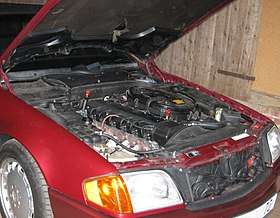Mercedes-Benz M103 engine
The Mercedes-Benz M103 was a straight-6 15 degrees, inclination to the right, automobile engine produced from 1984 to 1997. It was a single overhead cam design with 2 valves per cylinder. The M103 was replaced by the M104 starting in 1989. The bore spacing on the M103 engine is 97mm.
| Mercedes-Benz M103 engine | |
|---|---|
 | |
| Overview | |
| Manufacturer | Mercedes-Benz |
| Production | 1984 to 1997 |
| Layout | |
| Configuration | Naturally aspirated Straight-6 |
| Displacement | 2.6 L; 158.5 cu in (2,597 cc) 3.0 L; 180.6 cu in (2,960 cc) |
| Cylinder bore | 82.9 mm (3.26 in) 88.5 mm (3.48 in) |
| Piston stroke | 80.2 mm (3.16 in) |
| Valvetrain | SOHC 2 valves x cyl. |
| Compression ratio | 9.2:1 |
| RPM range | |
| Redline | 6200 |
| Combustion | |
| Fuel system | Continuous Injection System - Electronic |
| Fuel type | Gasoline |
| Oil system | Pressure circulation |
| Cooling system | Water cooled |
| Output | |
| Power output | 118–140 kW (160–190 PS; 158–188 hp) |
| Torque output | 220–260 N⋅m (162–192 lb⋅ft) |
| Chronology | |
| Successor | M104 |
3.0 L
The 103.980 engine 3.0 L; 180.6 cu in (2,960 cc) produces 132 kW (179 PS; 177 hp) at 5700 rpm with catalyst, 140 kW (190 PS; 188 hp) at 5700 rpm without catalyst, and has a torque of 255 N⋅m (188 lb⋅ft) at 4400 rpm (with catalyst), 260 N⋅m (192 lb⋅ft) at 4400 rpm without catalyst. It uses the CIS-E (Continuous Injection System - Electronic) and has a bore and a stroke of 88.5 mm × 80.2 mm (3.48 in × 3.16 in). The compression ratio is 9.2:1 with a redline of 6200 rpm. The firing order is 1-5-3-6-2-4. Lubrication system is pressure circulation lubrication system. Amount of oil in engine is 6 litres (1.6 US gal; 1.3 imp gal) and amount of coolant is 8.5 litres (2.2 US gal; 1.9 imp gal). Number of valves is 1 intake, 1 exhaust with V-shaped overhead configuration. Valve operation was 1 top camshaft. Camshaft drive was simple roller-type chain. Starter motor is electrical with 1.5 kW (2 PS; 2 hp); since 01.88 was 1.7 kW (2 PS; 2 hp). Ignition system is electronic ignition system. Recommended fuel octane for the M103 is 91 RON/MON (96 RON)(86 MON). This engine can be found in the W124 E-Class, W126 S-Class, Mercedes-Benz R129, W463 G-Class and the R107.
2.6 L
The smaller 103.940 engine 2.6 L; 158.5 cu in (2,597 cc) produces 118 kW (160 PS; 158 hp) at 5800 rpm with catalyst, 124 kW (169 PS; 166 hp) at 5800 rpm without catalyst, and generates torque at 220 N⋅m (162 lb⋅ft) at 4600 rpm with catalyst, 228 N⋅m (168 lb⋅ft) at 4600 rpm without catalyst. It also used the CIS-E engine management system and had a bore and a stroke of 82.9 mm × 80.2 mm (3.26 in × 3.16 in). The only mechanical differences from the M103 3.0 L to the M103 2.6 L were the decrease in bore, smaller intake valves and a slightly different airbox. The CIS-E components between 2.6 and 3.0 variants are all shared for any given model year with the exception of the ECU making engine swaps from 2.6 to 3.0 virtually bolt-in. This engine can be found in the W201 (190), W124 E-Class and W126 S-Class.